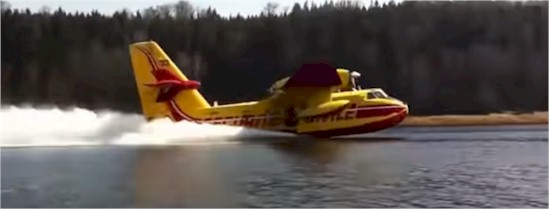|
|
|
Excerpt from en.wikipedia.org/wiki/Canadair_CL-215 The Canadair CL-215 is a twin-engine, high-wing general-purpose amphibious aircraft. It features an atypically spacious fuselage for an amphibian, which is designed to accommodate for the operational needs of various roles that the aircraft was developed to perform. The CL-215 can be used as an airborne firefighting platform, in which capacity it is used as a water bomber; it has been claimed to be the first aircraft designed to withstand the severe aerodynamic and hydrodynamic loads imposed by such usage. Beyond the water bomber role, the CL-215 was designed for use in other capacities, such as a search and rescue platform, passenger transport, and freighter; for this purpose, the cabin can be configured in various different ways, including a flexible combi configuration. The CL-215 was designed to perform well in the aerial firefighter role. The apparatus is designed around previously-proven concepts and careful design.The aircraft's belly houses a pair of 1,400 litres (300 imperial gallon) water tanks of which large downward-facing doors forms their bottoms; these open to rapidly discharge water over a target area. Bombardier Aerospace acquired Canadair during the 1980's and decided to terminate production of the type during the late 1980's. Although manufacturing did come to an end in 1990, a further improved model, designated as the CL-415, entered production during 1993. The last newly-built CL-415 was delivered in 2015 when production ended. Additionally, multiple conversion and refit programmes have been launched over the following decades to renovate and improve existing aircraft, typically focused on improving aspects such as the engines, avionics and structure. In 2018 Bombardier sold their design documents, and intellectual property rights, to the CL-215 and CL-415 to Viking Air who announced plans to open a production line to build the CL-515, an improvement over the CL-415, with more recent avionics, instrumentation to allow it to continue fighting fires at night, and the ability to fill other roles, like maritime surveillance, and maritime search and rescue, when it wasn't fire season. Editors' Note: Currently there are 54 CL-215, -215T and -415 aircraft registered in Canada. Note that -215T designates aircraft originally built with Pratt & Whitney R-2800 piston engines (as used on DC-6) and later converted to turboprops. Those factory-built with turboprops are designated CL-415. The 2nd CL-215 built, with the original piston engines, is still flying at age 55 (built 1968) with Yellowknife, Northwest Territories-based Buffalo Airways. |
|
Click the image below for the YouTube video, posted by Polyus, detailing the history, development and current status of this 'Scooper' firefighting series of aircraft. |
 |
|
Water Bombing Workhorse That Keeps On Evolving; |

